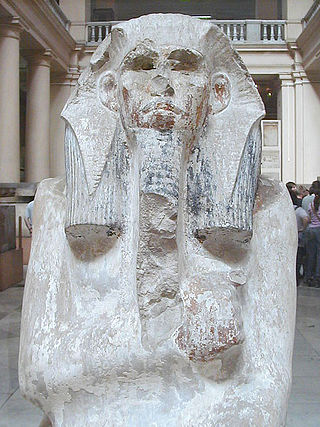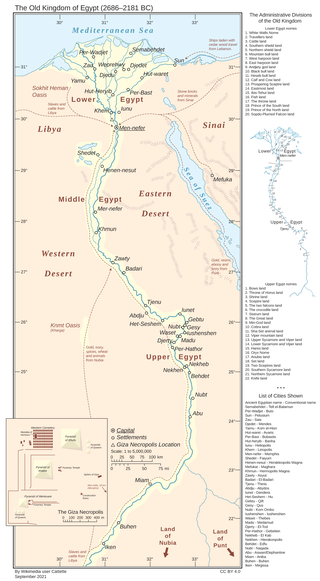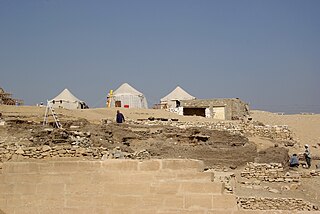
Memphis, or Men-nefer, was the ancient capital of Inebu-hedj, the first nome of Lower Egypt that was known as mḥw ("North"). Its ruins are located in the vicinity of the present-day village of Mit Rahina, in markaz (county) Badrashin, Giza, Egypt. This modern name is probably derived from the late Ancient Egyptian name for Memphis mjt-rhnt meaning "Road of the Ram-Headed Sphinxes".

Djoser was an ancient Egyptian pharaoh of the 3rd Dynasty during the Old Kingdom, and was the founder of that epoch. He is also known by his Hellenized names Tosorthros and Sesorthos. He was the son of King Khasekhemwy and Queen Nimaathap, but whether he was also the direct successor to their throne is unclear. Most Ramesside king lists identify a king named Nebka as preceding him, but there are difficulties in connecting that name with contemporary Horus names, so some Egyptologists question the received throne sequence. Djoser is known for his step pyramid, which is the earliest colossal stone building in ancient Egypt.

In ancient Egyptian history, the Old Kingdom is the period spanning c. 2700–2200 BC. It is also known as the "Age of the Pyramids" or the "Age of the Pyramid Builders", as it encompasses the reigns of the great pyramid-builders of the Fourth Dynasty, such as King Sneferu, who perfected the art of pyramid-building, and the kings Khufu, Khafre and Menkaure, who constructed the pyramids at Giza. Egypt attained its first sustained peak of civilization during the Old Kingdom, the first of three so-called "Kingdom" periods, which mark the high points of civilization in the lower Nile Valley.

Narmer was an ancient Egyptian pharaoh of the Early Dynastic Period. He was the successor to the Protodynastic king Ka. Many scholars consider him the unifier of Egypt and founder of the First Dynasty, and in turn the first king of a unified Egypt. He also had a prominently noticeable presence in Canaan, compared to his predecessors and successors. A majority of Egyptologists believe that Narmer was the same person as Menes. Neithhotep is thought to be his queen consort or his daughter.

Hor-Aha is considered the second pharaoh of the First Dynasty of Egypt by some Egyptologists, while others consider him the first one and corresponding to Menes. He lived around the 31st century BC and is thought to have had a long reign.

Ancient Egyptian art refers to art produced in ancient Egypt between the 6th millennium BC and the 4th century AD, spanning from Prehistoric Egypt until the Christianization of Roman Egypt. It includes paintings, sculptures, drawings on papyrus, faience, jewelry, ivories, architecture, and other art media. It was a conservative tradition whose style changed very little over time. Much of the surviving examples comes from tombs and monuments, giving insight into the ancient Egyptian afterlife beliefs.

Hor Awibre was an Egyptian pharaoh of the 13th Dynasty reigning from c. 1777 BC until 1775 BC or for a few months, c. 1760 BC or c. 1732 BC, during the Second Intermediate Period. Hor is known primarily thanks to his nearly intact tomb discovered in 1894 and the rare life-size wooden statue of the king's Ka it housed.

Khasekhemre Neferhotep I was an Egyptian pharaoh of the mid Thirteenth Dynasty ruling in the second half of the 18th century BC during a time referred to as the late Middle Kingdom or early Second Intermediate Period, depending on the scholar. One of the best attested rulers of the 13th Dynasty, Neferhotep I reigned for 11 years.

Nebka is the throne name of an ancient Egyptian pharaoh of the Third Dynasty during the Old Kingdom period, in the 27th century BCE. He is thought to be identical with the Hellenized name Νεχέρωχις recorded by the Egyptian priest Manetho of the much later Ptolemaic period.

Reserve heads are distinctive sculptures made primarily of fine limestone that have been found in a number of non-royal tombs of the Fourth Dynasty of Egypt; primarily from the reigns of pyramid-building pharaohs Khufu to Khafre, circa 2551–2496 B.C. While each of the heads share characteristics in common with each other, the striking individuality of the pieces makes them some of the earliest examples of portrait sculpture in existence. Their purpose is not entirely clear; the name comes from the prevalent theory first put forward in 1903 by the German Egyptologist Ludwig Borchardt, that the head was to serve as an alternate home for the spirit of the dead owner should anything happen to its body.

The Department of Ancient Egypt is a department forming an historic part of the British Museum, with Its more than 100,000 pieces making it the largest and most comprehensive collection of Egyptian antiquities outside the Egyptian Museum in Cairo.
Nubhetepti-khered was an ancient Egyptian king's daughter of the Thirteenth Dynasty. She is only known from her undisturbed burial at Dahshur which was discovered in 1894 by Jacques de Morgan, close to the pyramid of Amenemhat III.

Portraiture in ancient Egypt forms a conceptual attempt to portray "the subject from its own perspective rather than the viewpoint of the artist ... to communicate essential information about the object itself". Ancient Egyptian art was a religious tool used "to maintain perfect order in the universe" and to substitute for the real thing or person through its representation.

Khafre Enthroned is a Ka statue of the Pharaoh Khafre, who reigned during the Fourth Dynasty of ancient Egypt. It is now located in the Egyptian Museum in Cairo. The construction is made of anorthosite gneiss, a valuable, extremely hard, and dark stone brought 400 miles down the Nile River from royal quarries. This highlights Khafre's importance and power as a ruler. The statue was carved for the Pharaoh's valley temple near the Great Sphinx, a part of the necropolis used in funeral rituals. This Old Kingdom statue has an important function in Egyptian tombs as substitute abodes for the Pharaoh's ka—the life force that accompanied a person with a kind of other self. After death, the ka leaves the body into the afterlife, but still needs a place to rest: the statue.

The pyramid of Senusret III is an ancient Egyptian pyramid located at Dahshur and built for pharaoh Senusret III of the 12th Dynasty.

The Bust of Amenemhat V is a sculpture showing the head of the ancient Egyptian king Amenemhat V, who ruled at the beginning of the Thirteenth Dynasty. One of the major art works of this period, it is today in the Kunsthistorisches Museum in Vienna with the inventory number ÄS 37.

The Mastaba of Hesy-re is an ancient Egyptian tomb complex in the great necropolis of Saqqara in Egypt. It is the final resting place of the high official Hesy-re, who served in office during the Third Dynasty under King Djoser (Netjerikhet). His large mastaba is renowned for its well-preserved wall paintings and relief panels made from imported Lebanese cedar, which are today considered masterpieces of Old Kingdom wood carving. The mastaba itself is the earliest example of a painted tomb from the Old Kingdom and the only known example from the Third Dynasty. The tomb was excavated by the Egyptologists Auguste Mariette and James Edward Quibell.

Khenmet was an ancient Egyptian king's daughter of the Twelfth Dynasty, around 1800 BC. She is mainly known from her unrobbed tomb containing a set of outstanding personal adornments.
Nakht was an ancient Egyptian official living around 1950 BC under king Senusret I in the Twelfth Dynasty. His main title was high steward. As high steward he was responsible for the domains providing the palace and the royal residence with food and other resources.

Ita was an Ancient Egyptian king's daughter who lived in the 12th Dynasty around 1850 BC. She is known from the statue of a sphinx found in Qatna in modern Syria. The statue is today in the Louvre. On this statue she bears the titles noblewoman (iryt-p`t) and king's daughter of his body. She is perhaps further known from her burial next to the pyramid of king Amenemhat II at Dahshur. The burial was found intact and contained a decorated wooden coffin with longer religious texts including her name and a set of precious personal adornments, including a richly adorned dagger. It is uncertain whether both women are identical. The location of the tomb might indicate that she was a daughter of Amenemhat II.



















